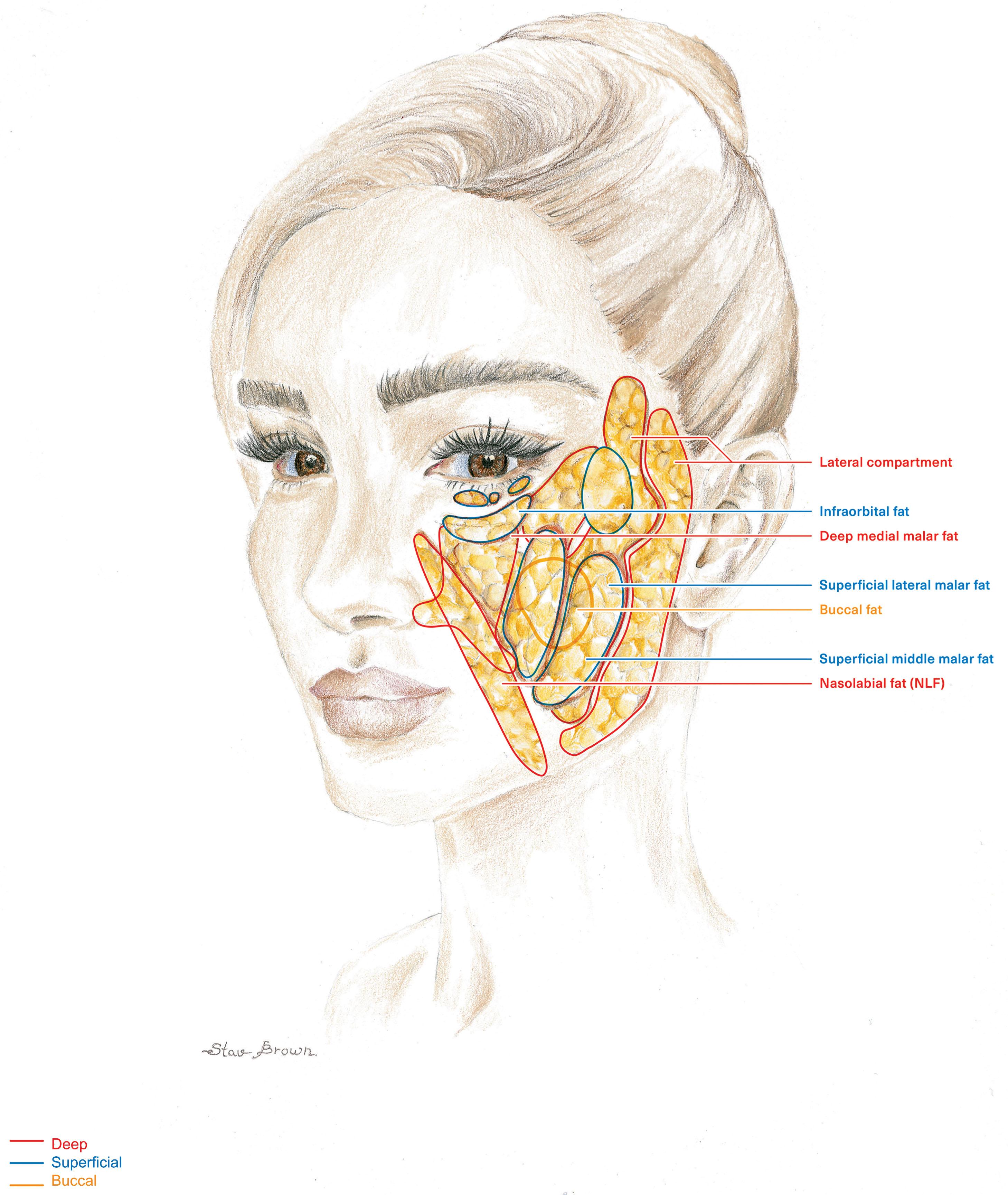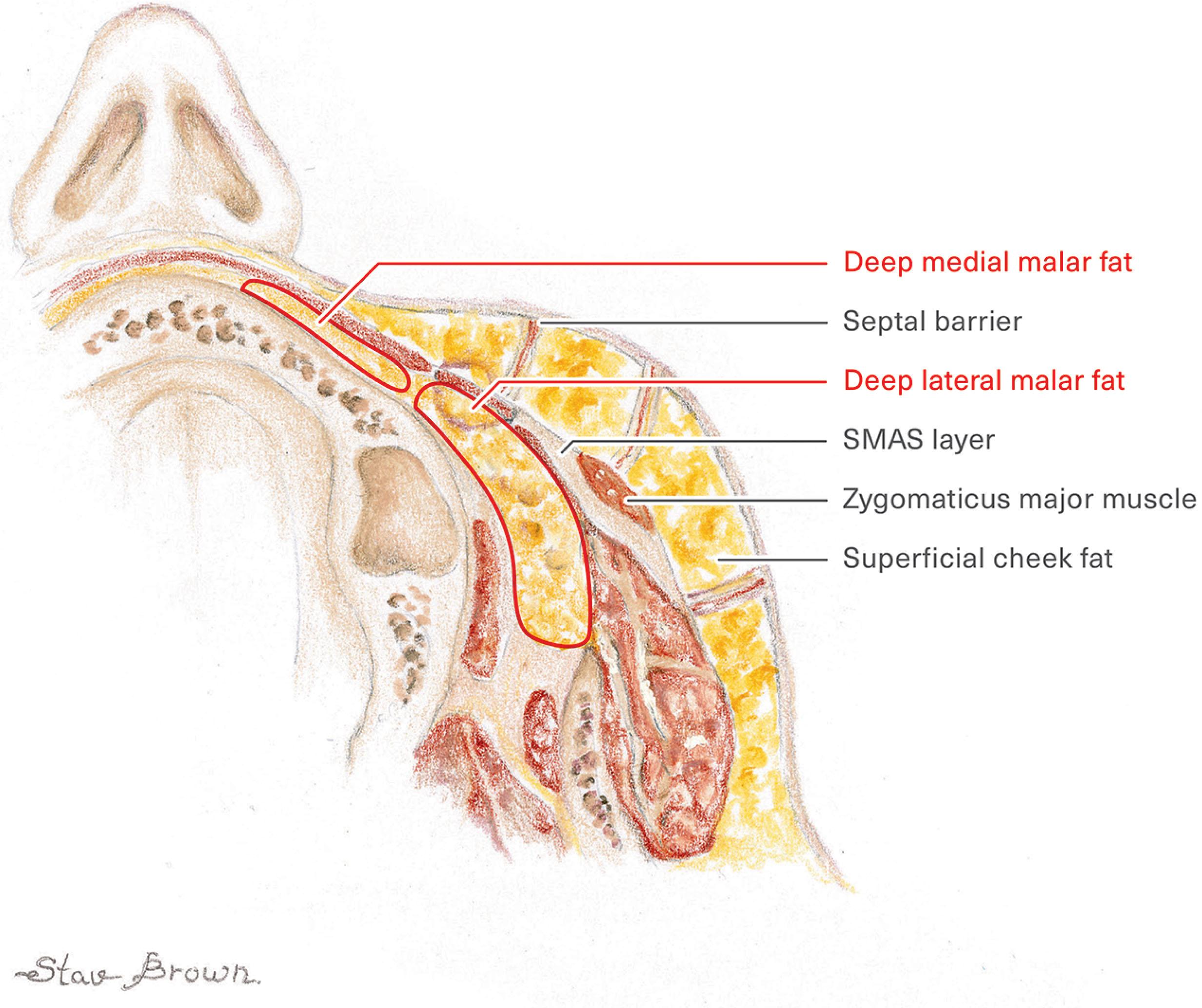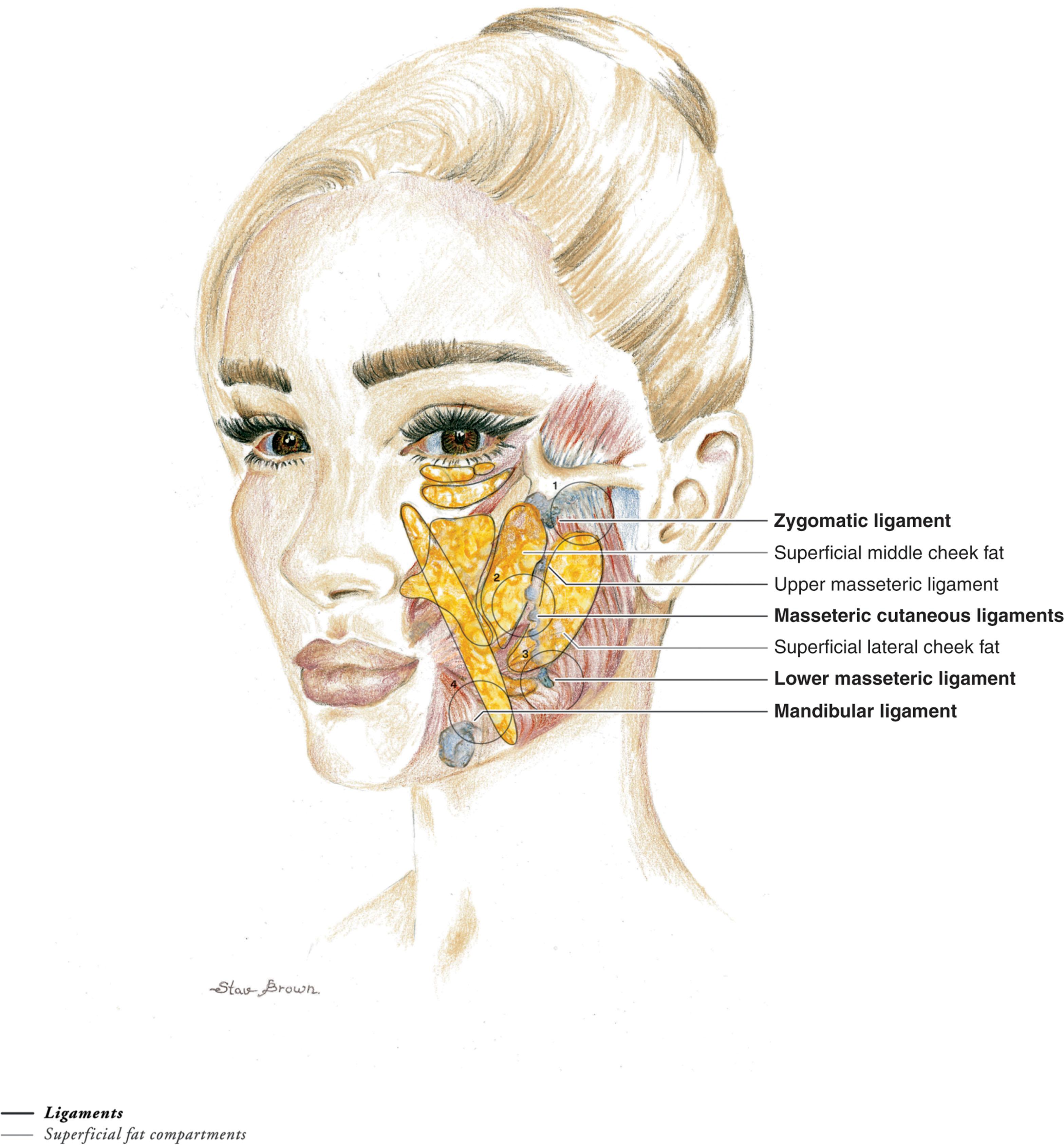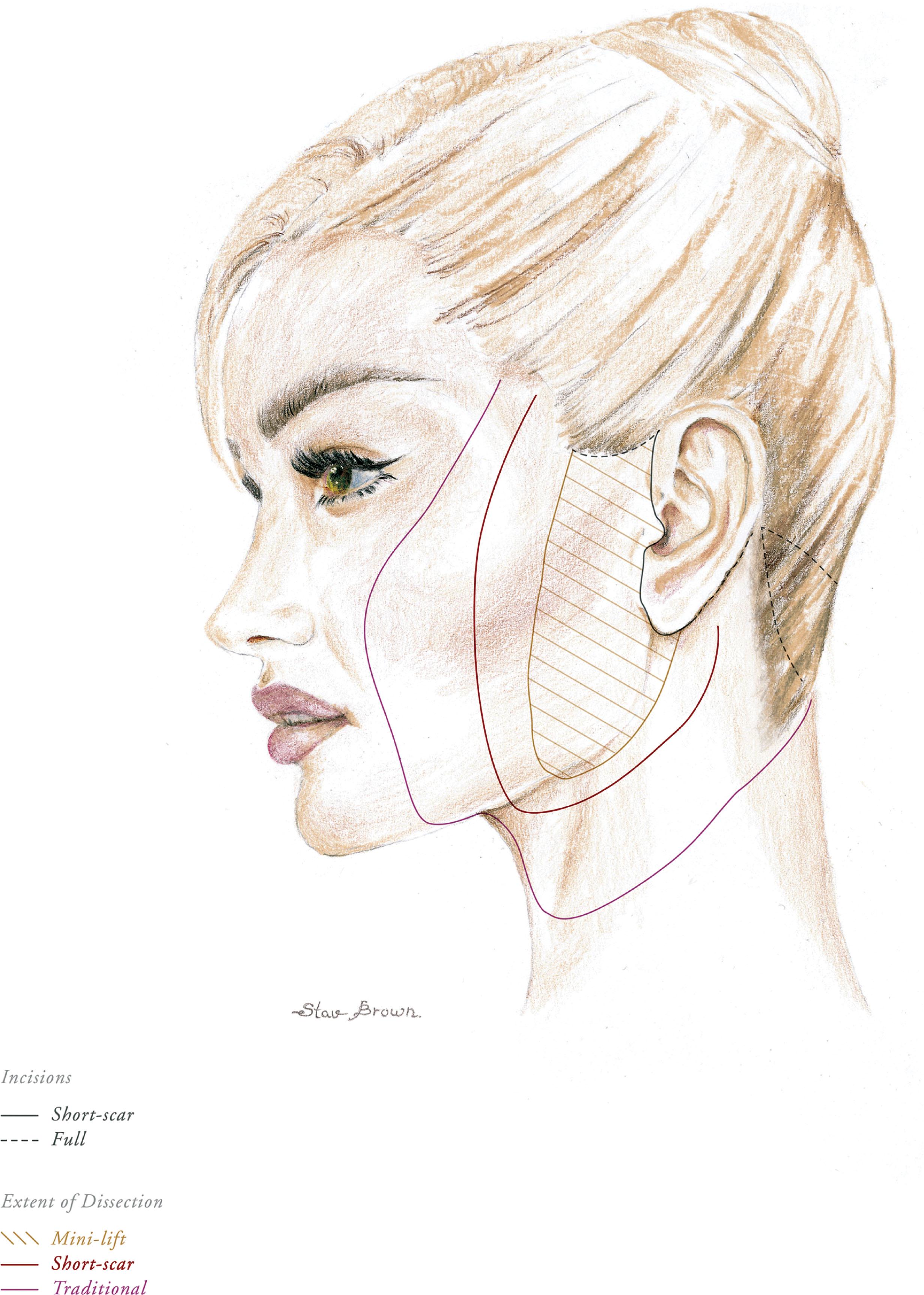Physical Address
304 North Cardinal St.
Dorchester Center, MA 02124
The science of facial aging as well as comprehensive knowledge of the anatomy of the facial fat compartments serve as the foundation of modern facial rejuvenation. Proper understanding of the fat compartments and danger zones in conjunction with contour-directed superficial musculo-aponeurotic system (SMAS) modifications is key to optimizing both safety and outcomes in facelifting procedures.
The primary processes involved in facial aging include deep compartment fat atrophy, secondary loss of structural support and superficial fat pseudoptosis, and the resulting loss of facial shape.
Historical changes in lift methodology clearly indicate the shortcomings of focusing solely on the extent of undermining, vectors and tension. Current facelift techniques have shifted from the single focus of SMAS alteration to volume restoration and facial recontouring via selective fat compartment volume augmentation.
The “lift-and-fill” technique has modernized facial rejuvenation, with precise volume augmentation as a crucial component of complete facial rejuvenation. The combination of an individualized alteration of the SMAS with precise volume augmentation allows for better control in facial recontouring while addressing volume deflation.
Careful analysis of facial shape preoperatively, intraoperatively and postoperatively is mandatory for successful outcomes as it allows for a tailored lift-and-fill facelift approach, optimizing facial balance and symmetry to improve facial harmony. Alternation of the direction of SMAS pull, along with individualized manipulation of SMAS volume, allow for a complete restoration of malar fullness and facial width.
The deep malar (medial) compartment and nasolabial fold are always augmented first, while the high lateral (superficial) compartment and nasolabial fold are augmented last.
SMAS stacking enhances width and is typically indicated for narrower faces or the narrower side. Alternatively, SMASectomy avoids enhancing fullness, which is indicated for the wider and fuller face or side.
Surgical complications including hematoma and sensory and motor nerve injuries can be prevented by careful dissection under direct vision with consistent skin flap thickness evaluation. Additionally, an antihypertensive protocol for postoperative hematoma prevention is used with proactive treatment of any potential contributory factors.
![]()
![]() Access video and lecture video content for this chapter online at Elsevier eBooks+
Access video and lecture video content for this chapter online at Elsevier eBooks+
Rhytidectomy remains a mainstay in facial rejuvenation today, with a 75% increase in cases observed over the past 20 years. With the longevity of a well-performed facelift lasting up to 10 to 12 years, rhytidectomy continues to be the most effective method of achieving long-lasting results compared to its non-surgical alternatives.
It is now understood that volume deflation is one of the key components of the complex facial aging phenomenon. As a result, the focus of modern facelifting has shifted from isolated superficial musculo-aponeurotic system (SMAS) alternation to volume restoration and facial recontouring. While tissue mobilization and elevation remain a mainstay in facial rejuvenation, precise volume restoration has become a fundamental component and a powerful tool in the armamentarium of the aesthetic plastic surgeon. According to a 2015 American Society of Plastic Surgeons survey, over 85% of surgeons use fat grafting at the time of facelift, and significantly higher satisfaction rates have been demonstrated among patients who undergo lipofilling at the time of facelift compared with those undergoing a facelift alone.
The lift-and-fill facelift, which has revolutionized the plastic surgeon’s approach to aging of the face, merges two key concepts in facial rejuvenation: (1) effective tissue manipulation by means of surgical lifting and tightening in differential vectors according to original facial asymmetry and shape; and (2) volumetric rejuvenation to the face via selective fat compartment filling of deep malar and high malar locations and nasolabial fold to precisely control facial contouring.
Various SMAS manipulation techniques have been described. However, to date, a single technique has not been shown to be superior to another. Therefore, more emphasis is given to creation of smooth contour and highlights through deep and superficial volume augmentation and less to the exact method of tissue reposition.
Using a combination of standardized preoperative and topographic visual analysis to target fat grafting to specific areas that have undergone deflation, and doing so before SMAS alteration, allows for better control in facial recontouring and results in successful correction of the aging face.
In-depth understanding of the anatomy of distinct facial fat compartments and a systematic method to assess areas of fat atrophy and volume depletion, alongside recognition of vascular danger zones, are therefore essential to optimizing patient outcomes and maintaining safety during facelift procedures.
This chapter provides an outline for the basic principles that have set the standard for the modern facelift. Based on both existing literature and clinical experience this chapter provides overviews of the principles of the lift-and-fill facelift while still allowing the experienced clinician ample flexibility in treatment strategy. In addition to a detailed text, broad reference base, instructional videos, and anatomic illustrations, we provide two clinical patient scenarios that demonstrate the key concepts of the lift-and-fill facelift technique.
Facial aging is a multifactorial process governed by both intrinsic (genetic) and extrinsic (environmental) factors that is the result of a complex interplay between the underlying craniofacial skeleton, mimetic musculature, compartmentalized facial fat, facial retaining ligaments, and the skin envelope.
An understanding of facial aging is fundamental to properly restoring natural, youthful and harmonious facial characteristics in facial rejuvenation procedures.
Collagen and elastin are the primary components of the skin. Toxic injury to these components, as well as atrophy of skin appendages and decreased extracellular matrix of the skin, contribute substantially to the process of aging through epidermal thinning, collagen loss and dermal elastosis over time.
With age, the facial skeleton undergoes clockwise rotation of the midface in relation to the cranial base. The maxilla increases in size and becomes posterior displaced, the orbital aperture enlarges, and the mandible decrease in size in both horizontal and vertical planes. Prior computed tomography (CT) studies have demonstrated that the relative prominence and position of facial soft tissues are substantially influenced by the morphologic changes of the facial bony skeleton, shifting the face’s overlying retaining ligaments and soft tissue, which in turn causes deflation of distinct facial fat compartments and gives the appearance of increased skin laxity and prominent folds in the nasolabial, periorbital, and jowl regions. These volumetric changes to both the facial bones and fat compartments further influence the facial mimetic muscles’ laxity and tension.
The concept of facial volume restoration has long been advocated as an important principle in facial rejuvenation with facial fat atrophy directly influencing both volume and shape of the aging face. The senior author (RJR) has extensively studied facial fat compartment anatomy and the role of facial fat atrophy in facial aging.
Once thought of as an anatomically continuous structure, the subcutaneous fat of the face has been shown to be highly compartmentalized in a multidimensional fashion.
Both volume deflation and distributional changes in these fat compartments contribute to the distinct morphology of the aging face, with volume deflation often preceding changes in volume distribution. Evidence for deflation as a primary component of facial aging has been clearly elucidated by Lambros, who has popularized the volumetric theory in his observations of midface and periorbital aging. In a photographic analysis of 130 subjects, he showed that the true descent of soft tissues might not be as profound as once thought, noting that the eyelid–cheek junction remained stable between the younger and older cohorts and therefore does not descend with age. Furthermore, skin landmarks such as moles and wrinkles in the periorbital and upper midface areas did not descend with time.
These findings further support fat compartment deflation as the main cause for undesirable and aged facial contour. The lift-and-fill facelift approach addresses volume deflation, the root cause of facial aging, allowing for less manipulation of the stable surface landmarks for a more natural facial appearance.
A series of dye-partition anatomic studies performed by Rohrich et al. elucidated the anatomy of superficial and deep facial fat compartments (see Fig. 9.9.1 ). They described the distinct fibrous septa separating the superficial and deep compartments extending from the fascial layer to the dermis. In 2014, in a cadaveric study comparing the adipocytes of the deep and superficial facial fat compartments, Wan et al . demonstrated a significant difference in size between the smaller adipocytes of the deep medial cheek compartment and those in the superficial nasolabial fat compartment, suggesting accelerated deflation in the deep compartments and further confirming the volumetric theory.

Another major force of facial aging is volume distribution and the formation of separations between the already defined fat compartments. In a youthful face the transition between subcutaneous compartments is smooth, whereas in aging individuals there are abrupt contour changes between regions.
Our understanding of the interplay between the deep and superficial fat compartments was further refined by introducing the concept of superficial fat “pseudoptosis”. Pseudoptosis results from the loss of support from deflation of deep compartments in conjunction with loss of support of the facial ligaments, resulting in anatomical descent of the superficial fat compartments and consecutive volume redistribution.
In a study comparing MRIs of older and younger faces, Gosain demonstrated relative descent in the position of the cheek fat. These findings were confirmed by Stuzin et al . who suggested that descent of the midfacial soft tissues, resulting clinically with soft tissue sagging described as radial expansion , is caused by age-related elastosis and attenuation of the fibrous attachments between the skin, fat, and deep fascia. In the senior author’s experience, facial fat atrophy in facial aging carries greater significance than soft tissue laxity and osseous changes. To demonstrate these findings, Rohrich et al . showed volume augmentation of the deep cheek fat compartments provided improved anterior cheek projection and reduced nasolabial crease. It is with these findings that facial fat grafting gained a high value in facial rejuvenation.
Age-associated soft tissue changes and loss of midface volume, particularly in the malar and submalar areas require both volume restoration, as well as repositioning of ptotic tissue and removal of redundant tissue. Anatomic studies have provided a topographic map of the superficial and deep facial fat compartments allowing an accurate and precise augmentation of deflated facial areas in conjunction with selective SMAS-shaping techniques. Based on these principles, the lift-and-fill facelift has revolutionized the approach to the aging face in aesthetic surgery.
The senior author routinely utilizes this powerful combination and selective fat compartment augmentation of the deep malar, nasolabial and oral commissures in every facelift.
In-depth understanding of the anatomy of the superficial and deep facial fat compartments is critical for precision in preoperative analysis and successful rejuvenation of the aging face. Fat compartments of the face are outlined in Table 9.9.1 and illustrated in Fig. 9.9.1 .
| Fat compartments | Anatomical landmarks |
|---|---|
| Superficial compartments | |
| Forehead – central compartment | Midline of forehead, bordered inferiorly by nasal dorsum |
| Forehead – middle temporal compartment | Bordered medially/laterally by central forehead fat, inferiorly by orbicularis retaining ligament |
| Forehead-lateral temporal malar compartment | Connects temporal fat to cervical fat, superficial to parotid gland |
| Periorbital – supraorbital compartment | Supraorbital, bordered superiorly and laterally by orbicularis retaining ligament |
| Periorbital – infraorbital compartment | Bordered inferiorly by orbicularis retaining ligament, immediately inferior to inferior lid tarsus |
| Periorbital – lateral orbital compartment | Bordered superiorly by inferior temporal septum, inferiorly by superior cheek septum |
| Cheek – middle malar compartment | Superiorly adherent to zygomaticus major, anterior and superficial to parotid gland |
| Cheek – high malar (lateral) compartment | Superior to middle malar fat |
| Jowl compartment | Bordered medially by lip depressor and inferiorly by platysma |
| Deep compartments | |
| Cheek – medial malar compartment | Bordered superiorly by orbicularis retaining ligament and lateral orbital compartment, lateral to nasolabial fold |
| Nasolabial fat compartment | Overlapping jowl fat, anterior to medial cheek fat |
The fat compartments and retaining ligaments of the face are intimately related. Retaining ligaments are soft-tissue support structures of the face arising from the underlying facial skeleton or deep fascia and are important landmarks in identifying the danger zones of facelift dissection. The three major retaining ligaments of the face include the zygomatic ligament, the mandibular ligament, and the masseteric cutaneous ligaments ( Figs. 9.9.2 & 9.9.3 , Table 9.9.2 ).


| Ligament | Origin |
|---|---|
| Zygomatic ligament | Zygomatic eminence at the superior junction of the middle cheek and infraorbital fat |
| Mandibular ligament | Tubercle of the mandible at the cheek–chin junction |
| Masseteric cutaneous ligaments | Masseteric fascia |
There are 23 superficial facial fat compartments. These encompass the forehead, periorbital, midface and lower face regions (see Fig. 9.9.1 & Table 9.9.1 ).
The superficial fat compartments of the cheek are separated by septal barriers arising from the SMAS (see Fig. 9.9.2 ). In the midface, these include part of the nasolabial fat and the lateral, middle, and medial cheek fat. Transition areas between compartments clinically correlate with zones of fixation that are encountered when dissecting a hemiface from lateral to medial and typically have some vascular component.
The nasolabial compartment is located medial to the deeper fat of the suborbicularis oculi fat (SOOF) compartment. It is bordered superiorly by the orbicularis retaining ligament and adherent to the lower border of the zygomaticus major muscle. In the cheek area, there are three distinct fat compartments: the medial, middle, and lateral-temporal cheek fat. Lateral to the nasolabial fold lies the medial cheek fat, bordered superiorly by the orbicularis retaining ligament and the lateral orbital compartment. The jowl fat can be found inferior to the medial cheek compartment. Anterior and superficial to the parotid gland the middle cheek fat can be found, partially adherent to the zygomaticus major in its superior portion. The zygomatic ligament can be noted in the confluence of these three superficial compartments. The parotidomasseteric ligaments are found where the medial fat compartment meets the middle cheek compartment.
The most lateral compartment of cheek fat is the lateral-temporal cheek compartment. When advancing medially from the pre-auricular incision during a facelift, the first transition zone encountered corresponds with a true septum located anterior to this compartment.
The lateral-temporal cheek compartment lies just superficial to the parotid gland, connecting the temporal fat to the cervical subcutaneous fat.
The deep compartments were later described and are found deep to the facial mimetic muscles overlying the maxilla (see Fig. 9.9.1 & Table 9.9.1 ). They influence anterior malar projection, blend the anterior cheek with the lateral cheek and provide structural support to the midface and the superficial fat compartments. Understanding the anatomy and the spectrum of their changes is vital for an individualized and tailored management strategy in facial rejuvenation.
Unlike the superficial fat compartments that can be altered by SMAS manipulation, the deep fat of the midface is primarily manipulated using volume restoration (see Fig. 9.9.2 ).
Deep fat compartments include the deep malar (medial) compartment, middle malar, nasolabial fold and superior cheek. Located under the orbicularis oculi muscle, the deep malar (medial) compartment is bordered laterally by the capsule of the buccal fat pad and the zygomaticus major muscle. Its medial boundary is formed by the pyriform ligament surrounding the nasal base and its superior border by the orbital retaining ligament. The deep medical cheek fat is supplied mainly by the infraorbital artery.
The most inferior fat on the face is the jowl fat compartment. It is bordered medially by the depressor anguli oris muscle, superiorly by nasolabial fat and medial fat, and inferiorly by the membranous fusion of the platysma muscle.
Septal boundaries separating facial compartments are composed of a vascularized fibrous membrane carrying an identifiable perforator supplying the skin. The nasolabial fat is the most medial of the major cheek compartments. It is separated from the upper lip fat by the nasolabial septum which contains perforator vessels from the angular artery. The lateral-temporal cheek fat, which is the most lateral fat compartment, is supplied by perforators arising from the branches of the superficial temporal artery. Medial to the lateral-temporal cheek compartment is the middle cheek fat. The medial limit of this compartment is formed by the middle cheek septum, which contains perforating branches from the transverse facial artery to the overlying skin. The medial fat compartment is located in between the middle cheek fat and nasolabial fat and supplied by perforators of the facial and infraorbital arteries.
Understanding the chronology of compartmental fat deflation with aging is integral to volumetric rejuvenation. Aging features that may be addressed with fat grafting are outlined in Table 9.9.3 .
| Facial area | Anatomical landmarks | Aging features | Management | Injection site (volume required) |
|---|---|---|---|---|
| Upper third |
|
|
|
|
| Middle third |
|
Deep tear trough deformity due to hollowing of the infraorbital region, laxity of the orbital retaining ligament, and loss of volume in the anterior cheek |
|
|
| Lower third |
|
|
|
|
The superficial lateral and medial, along with the deep medial, cheek compartments are classically affected early, followed by superficial malar deflation in the sixth decade. Inferior orbital rim becomes visible, as well as a centromedial cheek hollow below the tear trough, termed the V-deformity results. These findings can begin as early as the 40 s and are addressed by fat augmentation of the deep medial cheek, deep lateral cheek, and medial suborbicularis (SOOF). Cheek projection and a smooth transition between the anterior and lateral cheek can be achieved by deep lateral cheek augmentation. The jowl and nasolabial compartments witness less volume loss and become more prominent as supporting, deeper compartments start deflating. Volume loss in the deep lateral cheek, lateral temporal and forehead areas, which are also amenable to fat augmentation, is witnessed in the later decades.
The danger zones of the face are encountered in transition points between fat compartments or areas of dense retaining ligaments where transitions between tissue planes may occur and facial nerve branches are especially vulnerable to injury (see Fig. 9.9.3 ). The four danger zones encountered in facelift dissection are outlined in Table 9.9.4 .
| Danger zone | Location | Facial nerve branch |
|---|---|---|
| 1 | Between the region of the zygomatic and the upper masseteric ligaments, inferior and lateral to the zygomatic eminence | Zygomatic branch (become relatively superficial, may course over the zygomaticus major muscle origin to innervate the orbicularis oculi) |
| 2 | Anterior to the parotid, in the transition from the superficial lateral to middle cheek fat compartment | Buccal branch (in deep buccal fat pad) |
| 3 | Inferior masseteric border, where lower masseteric ligaments arise | Marginal mandibular branch (exits the tail of the parotid) |
| 4 | Mandibular ligament or cheek–chin junction | Marginal mandibular branch |
A wide variety of patients can be considered candidates for surgical facial rejuvenation procedures; however, a history of smoking, bleeding disorders, or surgical infections requires caution.
Optimal facial rejuvenation results require a multifaceted, patient-specific treatment plan that addresses skin, soft tissue support and fat atrophy. When tailoring a patient’s treatment, both facial volume and facial shape should be addressed. Symmetry assessment is a critical component of the preoperative evaluation. Described by Rohrich et al ., the individualized-component facelift takes into account regional asymmetries and applies the concepts of lifting and filling for facial rejuvenation. Fig. 9.9.4 demonstrates the technical sequence in the lift-and-fill facelift.

Differential fat augmentation is performed to treat volume asymmetry in conjunction with differential manipulations of the selective SMAS performed to each side to treat volume distributional asymmetry.
A preoperative discussion about the patient’s desired aesthetic goals and examination of photographs from the patient’s youth should be included as part of the preoperative planning in conjunction with a meticulous facial analysis. Indications for specific fat compartment augmentation are based on preoperative analysis of the topographic deflation. Accurate preoperative planning of selective fat compartment grafting is the first step in the lift-and-fill facelift. Three basic parameters should be addressed as part of facial analysis: midface width, facial length and facial fullness.
An individualized-component facelift technique not only allows varying vectors of pull but also serves in better tailoring differing techniques of SMAS manipulation to each face. The deep volumetric foundation influences the extent and type of SMAS and skin manipulation.
Management of the SMAS after fat grafting will be determined through assessment of the patient’s midface width and facial length. Each side of a patient’s face may benefit from a different technique in cases of significant asymmetry.
SMAS stacking is typically indicated for facial sides that are long and narrow and require more fullness, while SMASectomy is indicated for facial sides that are short and wide face to decrease facial fullness.
SMAS stacking performed superficial to the augmented deeper malar fat compartments not only allows differential augmentation in the exact topographic location that is indicated but also serves as a “contour bridge” between the deep medial and lateral superficial malar compartments.
In the setting of a fuller and/or wider facial side, where SMASectomy would be preferred, fat transfer volumes may be less indicated in the high lateral malar compartment to enhance the desired contour.
Evaluation of facial fullness will guide areas to be addressed with fat grafting, either alone or in conjunction with surgical techniques.
The face is divided into anatomical thirds and key features are systematically assessed. Transition points between the subcutaneous and deep fat compartments will manifest as visible folds in the aging face and areas of soft tissue redundancy.
Assessing the capacity of the recipient site is highly important in any fat grafting procedure. However, it is important to note that unlike breast and buttock tissue, the primary goal in facial fat grafting is not augmentation per se but “customized facial tissue mobilization”, and therefore precise assessment of the capacity of the recipient site is less critical. Superficial ligamentous release of tethered skin points is not necessary in facial fat grafting and may be required only at the lid/cheek junction or when dimpling occurs during closure.
Become a Clinical Tree membership for Full access and enjoy Unlimited articles
If you are a member. Log in here